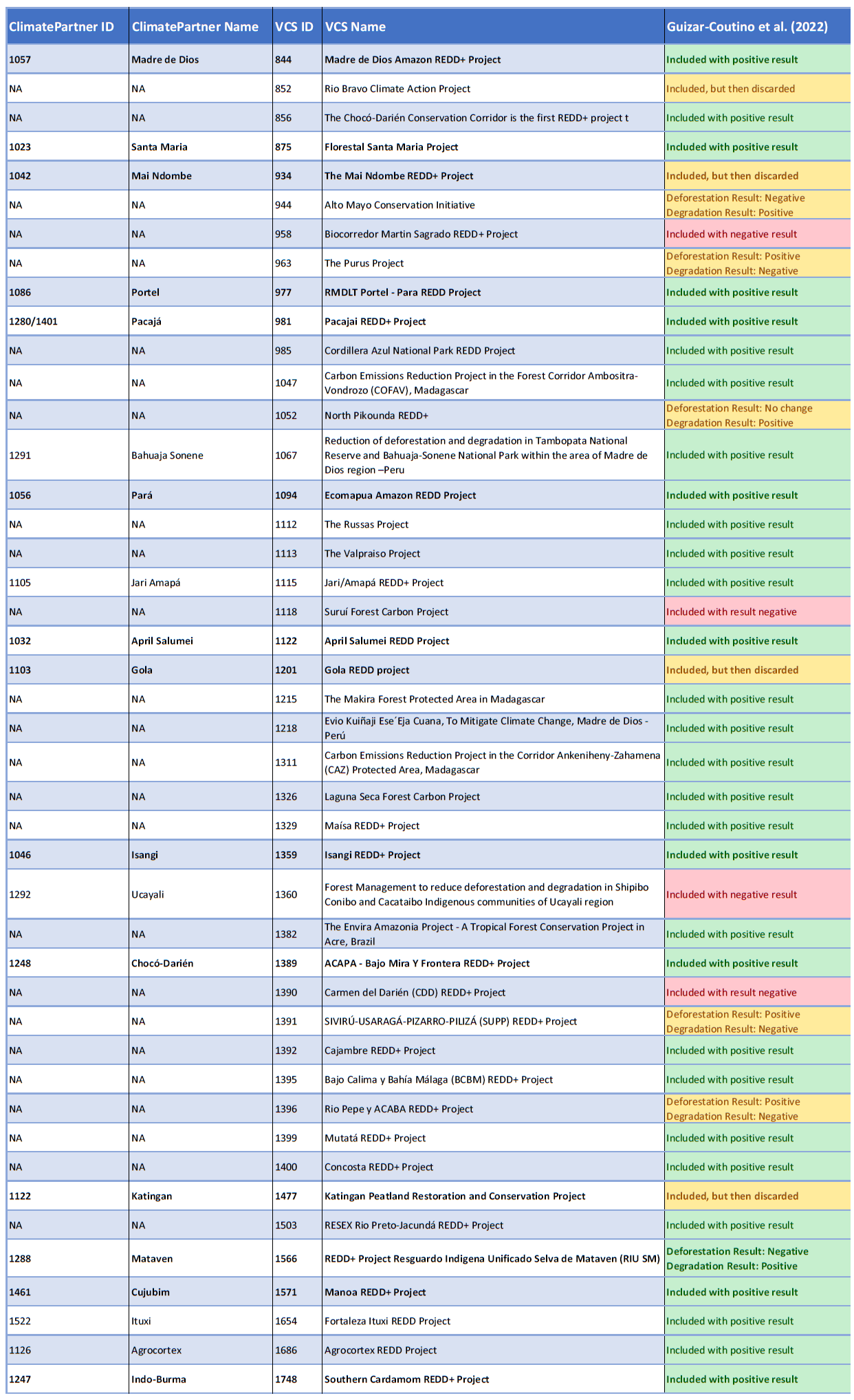Study analysis of "Guizar-Coutiño et al. (2022): A global evaluation of the effectiveness of voluntary REDD+ projects at reducing deforestation and degradation in the moist tropics"
February 1, 2023
In the wake of the accusations made by The Guardian and DIE ZEIT against Verra-certified forest conservation projects and the REDD+ mechanism, ClimatePartner has subjected the cited sources to a detailed analysis. Please see below the analysis of "Guizar-Coutiño et al. (2022): A global evaluation of the effectiveness of voluntary REDD+ projects at reducing deforestation and degradation in the moist tropics".
Other studies reviewed by ClimatePartner are West et al. 2020 and West et al. 2023.
A summary assessment of the study comparison as well as links to statements by other market participants are available here.
Study brief
Authors: Alejandro Guizar-Coutiño, Julia Patricia Gordon Jones, Andrew Balmford, Rachel Carmenta, David Coomes
Publishing details: December 2022; “Conservation Biology” Vol. 36, Issue 6; “Conservation Biology” is a bimonthly peer-reviewed scientific journal of the Society for Conservation Biology, published by Wiley-Blackwell and established in May 1987.
Method of Guizar-Coutiño et al. (2022):
- The study adopted a pixel-matching method, which means pixels are scattered over many sites instead of a single area.
- From initial data collection to analysis to publication, the study lasted for a total of two years from January 2019 to January 2022.
- A potential benefit of this approach claimed by the paper is that it ensures that the control set of pixels is exposed to the same geographic drivers of deforestation as the pixels in the sites of the actual REDD+ project areas.
- The method is applied to 43 VCS REDD+ projects which are mentioned in the study.
Projects evaluated in Guizar-Coutiño et al. (2022)
43 projects were analysed, of which 14 are or have been in ClimatePartner’s portfolio.

Please note: Projects highlighted in bold are or have been part of ClimatePartner’s portfolio.
Main findings of Guizar-Coutiño et al. (2022)
- The analysed REDD+ projects reduced deforestation by 47% and degradation by 58% in the first 5 years.
- The projects achieved greater reductions in deforestation and forest degradation where the threat of deforestation was greatest.
- There were consistent reductions in deforestation and forest degradation when comparing the effectiveness of REDD+ mechanism relative to matched pixels outside protected areas.
- However, despite the many challenges to just and economically sustainable implementation, the initial wave of REDD+ projects were effective at reducing forest loss.
Key highlights and Limitations
- It is the first study, to date, in which remotely sensed degradation and deforestation data were used to test whether voluntary REDD+ projects are effective at reducing small-scale temporary disturbances, alongside long-term deforestation, across a sample of geographically dispersed projects that differ in deforestation drivers and social objectives.
- The study sees the protection and restoration of natural forests as a possible nature-based climate action solution that is cost-effective and could have substantial impact if the many hurdles to implementation can be overcome.
- Estimating the impact of an intervention, such as REDD+, from observational data is inherently difficult because it relies on estimating what would have happened in the absence of the intervention. The study sees the need to standardise methodologies for establishing baselines with which to evaluate the effectiveness of forest-based interventions to reduce emissions.
Verra’s Technical Review of Guizar-Coutiño et al. (2022)
- The Guizar-Coutiño et al. study is mostly reliable because it contains only minor methodological deficiencies.
- It should be noted that this study examined deforestation and degradation rates only. This study did not convert estimates of deforestation and degradation to estimates of emission reductions, and the projects’ deforestation and degradation rates were not compared to the projects’ baselines as registered in Verra’s Registry.
- Verra finds that the authors’ use of data – reasonably high-resolution satellite data, though not on-the-ground data – means that their estimates of deforestation in their control areas are somewhat questionable.
- Verra further finds that the somewhat questionable nature of the estimates of deforestation in the control areas slightly undermines the authors’ conclusions about the REDD projects in question.
- Verra finds that the authors’ omission of some key factors in deforestation somewhat weakens the relevance of their control areas.
Additional comments by ClimatePartner
- ClimatePartner agrees with many of the fundamental findings from the study, including:
- REDD+ projects are crucial for protecting natural forests, along with non-carbon ecosystem services such as water and soil health.
- Incentivising forest conservation through voluntary site-based projects can slow tropical deforestation and highlight the particular importance of prioritising financing for areas at greater risk of deforestation.
- Pixel-matching methods used to create control areas, as conducted in the study by Guizar-Coutiño et al. (2022), can add a more objective component to evaluating a project’s performance. The approach in this study is thus very valuable to the evolvement of methodologies to evaluate REDD+ projects.
- While the approach used by Guizar-Coutiño et al. is important to foster ongoing scientific discourse it is still neither peer-reviewed nor validated for the assessment of REDD+ projects under Verra.